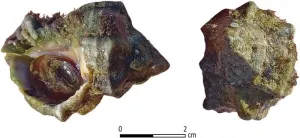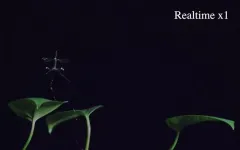Marine radar can accurately monitor vessel speeds to protect whales, study finds
Radar technology can detect vessel speed violations with 95% confidence
2025-04-16
(Press-News.org) A new study by researchers at ProtectedSeas highlights the potential of marine radar technology to monitor speed of small vessels. The research, aimed at testing the accuracy of radar in assessing potential violations, found that the technology could detect speed violations with 95% confidence, offering a promising solution to help reduce the threat of vessel strikes on whale populations. The analysis was recently published in the journal Sensors.
The impact of small vessels on whales is becoming a growing concern in busy marine environments due to the increasing number of recreational and commercial boats in these areas. A 2020 study led by the ProtectedSeas team found that smaller boats can represent 34% of traffic in busy ports like San Francisco Bay. Unlike large commercial vessels, which are often monitored using the Automatic Identification System (AIS), smaller boats tend to go undetected, making it harder to enforce speed limits and prevent strikes, especially in areas where whales are feeding or migrating.
“Radar is a widely available tool that is accessible to a large audience, such as enforcement agencies, marine resource managers, and researchers,” said the study’s lead author Samantha King, senior scientist for ProtectedSeas Marine Monitor (M2). The accuracy values from our study can be used to confidently enforce speed limits using radar.”
The research team conducted the large-scale study comparing radar and AIS data from the M2 system across 3,097 vessel tracks at ten locations to estimate the accuracy of radar-reported vessel speeds.
The analysis found a strong correlation between radar and AIS speeds, with vessels traveling within 1.8 knots of radar-reported speeds to AIS values with 95% confidence. Understanding radar speed accuracy enables reliable reporting and analysis, supporting effective design, monitoring, and enforcement of vessel speed limit measures.
According to the researchers, radar technologies like M2 can effectively monitor speed limits to help reduce vessel collisions with endangered whales, particularly in areas like the North Atlantic right whale seasonal management areas along the U.S. East Coast, where fewer than 370 individuals remain.
“This study confirms that marine radar, similar to road speed monitors, can be used to track the speeds of smaller vessels that are not equipped with AIS,” said M2 Co-founder Brendan Tougher, a coauthor of the study. “Marine radar technology can be an effective tool to monitor and enforce speed limits for smaller vessels to better protect whale populations.”
# # #
ProtectedSeas’ Marine Monitor (M2) is a shore-based vessel monitoring platform designed to document a variety of activities in the nearshore marine environment by utilizing a marine radar to detect and track vessels and a pan-tilt-zoom camera for capturing images.The M2 system operates fully autonomously, ensuring uninterrupted, year-round data collection of vessels ranging from commercial shipping to recreational boats. Its robust and self-sufficient design allows deployment in remote and rugged areas. Learn more at: https://m2marinemonitor.com.
END
[Attachments] See images for this press release:


ELSE PRESS RELEASES FROM THIS DATE:
2025-04-16
The National Center to Reframe Aging — the leading organization for proven communication strategies and tools to effectively frame aging issues — is partnering with The West End Home Foundation (WEHF), an independent charitable foundation located in Nashville, Tennessee.
The National Center to Reframe Aging will be a strategic partner to support the WEHF’s mission to enrich the lives of older people through grant making, advocacy, and community collaboration. Key leaders of the Tennessee Department of Disability and Aging and the Tennessee aging network will participate in educational opportunities and receive tools from the National Center ...
2025-04-16
EMBARGOED FOR RELEASE UNTIL 4:00 P.M. ET, WEDNESDAY, APRIL 16, 2025
MINNEAPOLIS — A new study has found important clues about the roles age, sex, hormonal changes and genetics play in how certain biomarkers for dementia are expressed in the blood, according to a study published on April 16, 2025, online in Neurology®, the medical journal of the American Academy of Neurology.
“Blood tests that detect biomarkers for Alzheimer's disease and other dementias are emerging and as these tests are further developed, they are becoming important tools for understanding and diagnosing ...
2025-04-16
Large, grand-design spiral galaxies like our own Milky Way are common in the nearby Universe. But they have proven hard to find in the early Universe, which is consistent with expectations that large disks with spiral arms should take many billions of years to form. However, assistant astronomer Christina Williams of NSF NOIRLab, which is funded by the U.S. National Science Foundation, has discovered a surprisingly mature spiral galaxy just one billion years after the Big Bang [1]. This is the most distant, earliest known ...
2025-04-16
Iron Age purple dye "factory" in Israel was in operation for almost 500 years, using mollusks in large-scale specialized manufacturing process
Article URL: https://plos.io/44elLDX
Article title: Tel Shiqmona during the Iron Age: A first glimpse into an ancient Mediterranean purple dye ‘factory’
Author countries: U.S., Israel
Funding: The author(s) received no specific funding for this work. END ...
2025-04-16
In a new study of people with long-term vegan diets, most ate an adequate amount of total daily protein, but a significant proportion did not meet required levels of the amino acids lysine and leucine. Bi Xue Patricia Soh and colleagues at Massey University, New Zealand, present these findings in the open-access journal PLOS One on April 16, 2025.
Proteins are made up of various molecular “building blocks” known as amino acids. While the human body can synthesize most of the amino acids we need to live, we completely rely on the ...
2025-04-16
The Harvard RoboBee has long shown it can fly, dive, and hover like a real insect. But what good is the miracle of flight without a safe way to land?
A storied engineering achievement by the Harvard Microrobotics Laboratory, the RoboBee is now outfitted with its most reliable landing gear to date, inspired by one of nature’s most graceful landers: the crane fly.
Publishing in Science Robotics, the team led by Robert Wood, the Harry Lewis and Marlyn McGrath Professor of Engineering and Applied Sciences in the John A. Paulson School ...
2025-04-16
Analysis of job applicant data from one large employer suggests that a policy meant to improve employment prospects for people with criminal records did not actually lead to changes in job offers for people with records. Deborah Weiss of Northwestern University, U.S., and colleagues present these findings in the open-access journal PLOS One on April 16, 2025.
Parts of the U.S. have introduced “Ban-the-Box” (BTB) laws, which aim to improve job prospects for people with criminal records. ...
2025-04-16
ANN ARBOR—Ancient Homo sapiens may have benefitted from sunscreen, tailored clothes and the use of caves during the shifting of the magnetic North Pole over Europe about 41,000 years ago, new University of Michigan research shows.
These technologies could have protected Homo sapiens living in Europe from harmful solar radiation. Neanderthals, on the other hand, appear to have lacked these technologies and disappeared around 40,000 years ago, according to the study, published in Science Advances and led by researchers at Michigan Engineering and the U-M Department of Anthropology.
The team found ...
2025-04-16
Astronomers have found a planet that orbits at an angle of 90 degrees around a rare pair of peculiar stars. This is the first time we have strong evidence for one of these ‘polar planets’ orbiting a stellar pair. The surprise discovery was made using the European Southern Observatory’s Very Large Telescope (VLT).
Several planets orbiting two stars at once, like the fictional Star Wars world Tatooine, have been discovered in the past years. These planets typically occupy orbits that roughly align with the plane in which their host stars orbit each ...
2025-04-16
Astronomers have discovered a planet that orbits at a 90-degree angle around a rare pair of strange stars – a real-life ‘twist’ on the fictional twin suns of Star Wars hero Luke Skywalker’s home planet of Tatooine.
The exoplanet, named 2M1510 (AB) b, orbits a pair of young brown dwarfs — objects bigger than gas-giant planets but too small to be proper stars. Only the second pair of eclipsing brown dwarfs known – this is the first exoplanet found on a right-angled path to the orbit of its two host stars.
An international team of researchers led ...
LAST 30 PRESS RELEASES:
[Press-News.org] Marine radar can accurately monitor vessel speeds to protect whales, study finds
Radar technology can detect vessel speed violations with 95% confidence







